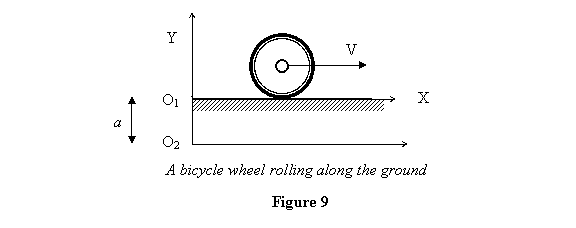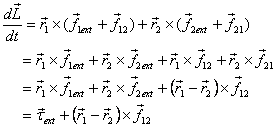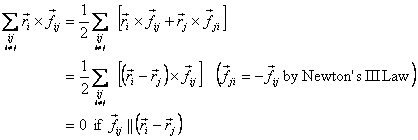After this initial demonstration
of  with
a single particle, we move on to a system of many particles.
It is really a system of many particles that we are dealing
with in rigid-body dynamics.
with
a single particle, we move on to a system of many particles.
It is really a system of many particles that we are dealing
with in rigid-body dynamics.
Angular Momentum of a collection of particles: If
there are many particles then the total angular momentum  about
a point O is the sum of individual angular
momenta of each particle about O . Thus
about
a point O is the sum of individual angular
momenta of each particle about O . Thus

As for the angular momentum of a single particle, the
angular momentum of a many-particle system is also origin-dependent.
(Question: Under what
conditions will the angular momentum be independent of
the origin?)
Now recall that the kinetic energy for a collection of
particles is the sum of the kinetic energy of their centre
of mass (CM) and the kinetic energy of particles with
respect to the CM. Interestingly the angular momentum
of a many-particle system can be expressed in the same
manner. Thus the total angular momentum of a collection
of particles is equal to the angular momentum of the
CM plus the angular momentum of particles about the CM.
Let us now prove it. To do so express the position vector
and the velocity of a particle as

where  refer
to the position and velocity of the CM and
refer
to the position and velocity of the CM and  the
position and velocity of ith particle with
respect to the CM. Now the total angular momentum can
be writes as
the
position and velocity of ith particle with
respect to the CM. Now the total angular momentum can
be writes as

However, by definition of the CM,  .
Therefore the second and the last term in the expression
above do not contribute. The remaining terms are written
as
.
Therefore the second and the last term in the expression
above do not contribute. The remaining terms are written
as

where M is the total mass of the system. This is a remarkable
result, and as we will see, facilitates calculations
involving rigid-body dynamics a lot. Keep in mind though
that this result is true only with for the CM. For an
arbitrary point O' in the body, we cannot write

because  depends
explicitly on the definition of the CM. We will later
use this fact to obtain the parallel axis theorem that
you may have learnt in your previous classes. The theorem
is similar to the transfer theorem of the second-moment
of an area.
depends
explicitly on the definition of the CM. We will later
use this fact to obtain the parallel axis theorem that
you may have learnt in your previous classes. The theorem
is similar to the transfer theorem of the second-moment
of an area.
The relationship  also
tells us that if the total momentum of a system of particles
is zero, its angular momentum will be independent of
the origin. I leave the simple proof for you to work
out.
also
tells us that if the total momentum of a system of particles
is zero, its angular momentum will be independent of
the origin. I leave the simple proof for you to work
out.
Example: Take a bicycle wheel of radius R rolling
along the ground and assume all its mass M is
concentrated along the rim. If it is rolling without
slipping then its motion is as follows: its CM moves
with speed V along a straight line and the
wheel rotates about the CM with angular speed  so
that the point on ground is at rest. We want to find
its angular momentum in a frame stuck to the ground such
that the wheel is moving along its x-axis see figure
9).
so
that the point on ground is at rest. We want to find
its angular momentum in a frame stuck to the ground such
that the wheel is moving along its x-axis see figure
9).

The angular momentum of the wheel about its CM is given
as

So angular momentum about the origin O1 (see
figure 9) would be

On the other hand, if we were to calculate the angular
momentum about O2 (see figure 9) it would come out to
be

Notice that in both the cases we have added the angular
momentum of the CM and that about the CM. It is because
their directions come out to be the same (negative z
direction). One must be careful about these things because
angular momentum is a vector quantity. Having introduced
you to the concept of angular momentum, I now discuss
about the rate of its change for a many-particle system
where the particles are interacting with each other also.
Dynamic of a rigid body;  and
conservation of angular momentum: Let us
now look at
and
conservation of angular momentum: Let us
now look at  in
the case of a collection of particles which are interacting
with each other and are also being acted upon by
external forces.
in
the case of a collection of particles which are interacting
with each other and are also being acted upon by
external forces.

But  (
(  s
the total force, i.e. the sum of external and internal
forces on the particle). This gives
s
the total force, i.e. the sum of external and internal
forces on the particle). This gives

Before simplifying this equation in terms of the external
torque, let us see where does this equation lead us for
a two particle system shown in figure 10?

The two particles 1 and 2 shown in figure 10 are external
forces  ,
respectively. They also interact with each other
with particle 2 applying a force
,
respectively. They also interact with each other
with particle 2 applying a force  on
particle 1 and particle 1 applying a force
on
particle 1 and particle 1 applying a force  on
particle 2. We assume the forces to be following
Newton 's IIIrd law so that
on
particle 2. We assume the forces to be following
Newton 's IIIrd law so that  .
Now the rate of change for this system can be
written as
.
Now the rate of change for this system can be
written as

Thus the rate of change of angular momentum is equal to
only the external torque if  or
or  ,i.e.
the force between the particles is along the line joining
them. At this point I would like you to recall that in
the case of linear momentum, the rate of change on linear
momentum equals the total external force, i.e.
,i.e.
the force between the particles is along the line joining
them. At this point I would like you to recall that in
the case of linear momentum, the rate of change on linear
momentum equals the total external force, i.e.  .
For angular momentum to satisfy
.
For angular momentum to satisfy  ,
the additional condition of
,
the additional condition of  is
also needed. Fortunately for most of the mechanical applications
this is true. Let us now generalize this to the case
of a many-particle system. For such a system
is
also needed. Fortunately for most of the mechanical applications
this is true. Let us now generalize this to the case
of a many-particle system. For such a system

Recall the trick used in the case of linear momentum that

so that

Under these conditions, i.e. if the force between
the particles is along the line joining them ,
we get

Thus if  then
then  .
Thus is the law of conservation of total angular
momentum. In the next lecture we will do a few
example of its application.
.
Thus is the law of conservation of total angular
momentum. In the next lecture we will do a few
example of its application.
We now conclude this lecture by listing the following
points that we have learnt:
- A rigid body needs six parameters to describe
its general motion; three for translation
and three for rotation,
- Dynamics of rigid
body is governed by its angular momentum,
- The
angular momentum satisfies the
equation

under the condition that the internal forces satisfy
Newton 's IIIrd law and an additional condition that 
4. 